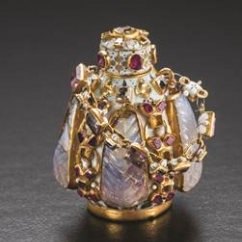Articles and News
Industry News: G&G Offers Glimpse Of Rare, Hidden Collection; NY Diamond Week, More October 30, 2013 (0 comments)

G&G Features A Behind-the-Scenes Look At Rare Hidden Jewelry Collection
Carlsbad, CA—The Fall 2013 issue of Gems & Gemology, the quarterly journal published by GIA, features a special look at the Cheapside Hoard, an astonishing exhibit of centuries-old jewelry now on display at the Museum of London.
The Cheapside Hoard is a collection of nearly 500 gems and jewels that were buried in the 17th century and left undisturbed underground in London until a chance discovery in 1912. Among the pieces chronicled are a gold locket featuring an image of Elizabeth I, a delicately carved cameo inspired by the Aesop fable “The Dog and His Reflection,” and an enameled gold ring set with a table-cut diamond, an evolutionary cut developed in the mid-fifteenth century.
G&G’s cover story offers a remarkable preview of the collection, and Museum of London Director Sharon Ament and Senior Curator Hazel Forsyth discuss both the remarkable history and gemological significance of the collection, which is being exhibited for the first time since the Hoard’s discovery. The exhibit is on display now through April 27, 2014.
The issue also discusses “digits,” a naturally occurring pattern resembling fingers that is most often found in Ethiopian opal; unveils a useful clue indicating corundum heat treatment; reports on agates from Morocco; and much more. It’s available in print, and online with exclusive video content.
Pictured at top left is a scent bottle, or pomander, from the Cheapside Hoard. The bejeweled handle implies that it was hung from a chain. This gold bottle with white enamel is set with milky chalcedony carvings of leaves, rubies, pink sapphires, spinels, and diamonds. The bottle would have contained musk oils combined with essential oils, ambergris, and other substances to prolong the perfume. Courtesy of the Museum of London; photo by Robert Weldon/GIA.
Israel Diamond Week in New York Set For November 11-14
Ramat Gan, Israel—Israel Diamond Week in New York, a joint venture of the Diamond Dealers Club of New York (DDC) and the Israel Diamond Exchange (IDE), will be held November 11-14 on the DDC trading floor at 580 Fifth Avenue in Manhattan. The event aims to boost the trade between the two bourses' members, to renew business between local suppliers and their clients, and to lower the threshold for jewelry manufacturers and retailers who wish to get access to the Club.
"For American retailers, this is an excellent opportunity to source a wide variety of quality diamonds directly from manufacturers, at very favorable prices," IDE president Shmuel Schnitzer noted.
Unity Marketing: Affluents Not So Upbeat About Christmas
Stevens, PA—In a departure from other studies expecting modest to solid growth for holiday spending, Unity Marketing is predicting a more pessimistic mood among the affluent consumer segment.
A new survey conducted in early October predicts a weak turnout for holiday, says Pamela Danziger, president of Unity Marketing and lead researcher on its Luxury Tracking study. "While the survey was conducted October 3-10, during the 16-day government shutdown, affluents see continued uncertainty in terms of governmental policy and its impact on business. That uncertainty is measured in a sharp drop in the Luxury Consumption Index,” she says. One-fourth of the respondents to Unity’s survey plan to spend less this year on holiday gifts as compared with last year, while only 18% expect to spend more. The Unity study says the average amount affluents expect to spend on holiday gifts is $1,730. This still is more than double the National Retail Federation’s average estimate of approximately $738 among all shoppers.
By contrast, the American Affluence Research Center predicts spending of $2,513 per affluent household, with a possible increase in that amount as the season gets underway. Deloitte’s holiday survey predicts a 4-4.5% increase in holiday spending over last year, while NRF predicts a 3.9% increase overall and ShopperTrak predicts a more modest 2.4% increase.
The divergence in attitudes among affluent consumers is very likely a function of just how affluent they are. AARC’s survey polled the wealthiest 10% of U.S. consumers, with an average net worth of $3.1 million. Its figures do show a slight dip in holiday spending intention per household, but an overall increase in the number of ultra-affluent households planning to shop, resulting in a net gain for the season. It also found their view of the economy is at a six-year high.
The 1,208 consumers polled in Unity’s survey have an average income of $267,100. With the standard definition of affluent as income above $75,000, this falls well within the bounds of affluence, but remains firmly in the “mass affluent” demographic. Unity calls these consumers “HENRYs”, or High Earner, Not Rich Yet. Of all affluent consumers, this group was hardest hit by the recession, as their wealth often is predicated on dual incomes. Unity’s fall 2013 survey found their views of the economy to be the most pessimistic since 2008 and 2009.
Danziger says deep discounts will be the most important feature for these affluents when choosing a gift this holiday season. She suggests that retailers will have to pull out all stops in terms of promotions and discounting. The second most important feature will be “Made in the USA,” reflecting a growing trend for supporting domestic business.







